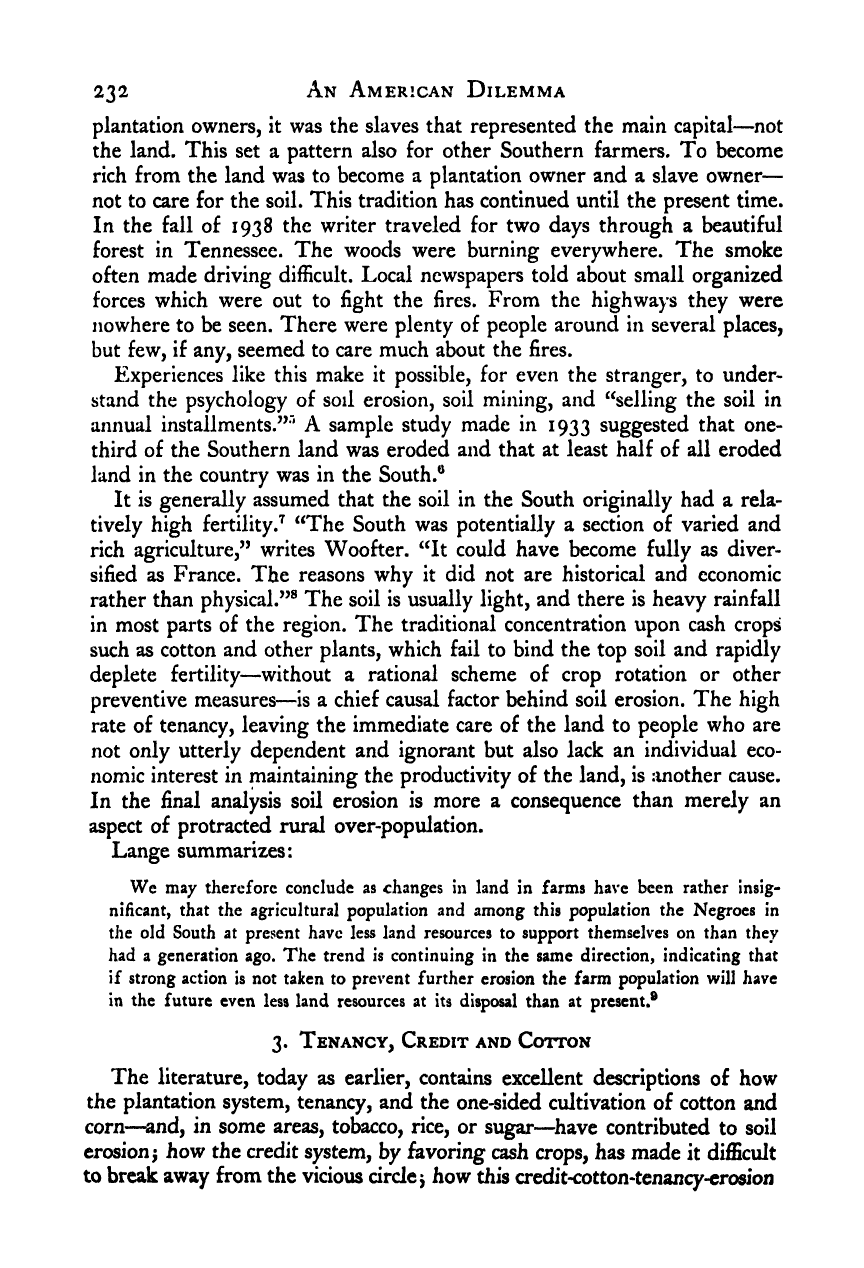Note: Gunnar Myrdal died in 1987, less than 70 years ago. Therefore, this work is protected by copyright, restricting your legal rights to reproduce it. However, you are welcome to view it on screen, as you do now. Read more about copyright.
Full resolution (TIFF) - On this page / på denna sida - IV. Economics - 11. The Southern Plantation Economy and the Negro Farmer - 2. Overpopulation and Soil Erosion - 3. Tenancy, Credit and Cotton

<< prev. page << föreg. sida << >> nästa sida >> next page >>
Below is the raw OCR text
from the above scanned image.
Do you see an error? Proofread the page now!
Här nedan syns maskintolkade texten från faksimilbilden ovan.
Ser du något fel? Korrekturläs sidan nu!
This page has never been proofread. / Denna sida har aldrig korrekturlästs.
232 An American Dilemma
plantation owners, It was the slaves that represented the main capital—not
the land. This set a pattern also for other Southern farmers. To become
rich from the land was to become a plantation owner and a slave owner
—
not to care for the soil. This tradition has continued until the present time.
In the fall of 1938 the writer traveled for two days through a beautiful
forest in Tennessee. The woods were burning everywhere. The smoke
often made driving difficult. Local newspapers told about small organized
forces which were out to fight the fires. From the highways they were
nowhere to be seen. There were plenty of people around in several places,
but few, if any, seemed to care much about the fires.
Experiences like this make it possible, for even the stranger, to under-
stand the psychology of soil erosion, soil mining, and “selling the soil in
annual installments.”’* A sample study made in 1933 suggested that one-
third of the Southern land was eroded and that at least half of all eroded
land in the country was in the South.®
It is generally assumed that the soil in the South originally had a rela-
tively high fertility.^ “The South was potentially a section of varied and
rich agriculture,” writes Woofter. “It could have become fully as diver-
sified as France. The reasons why it did not are historical and economic
rather than physical.”® The soil is usually light, and there is heavy rainfall
in most parts of the region. The traditional concentration upon cash crops
such as cotton and other plants, which fail to bind the top soil and rapidly
deplete fertility—without a rational scheme of crop rotation or other
preventive measures—is a chief causal factor behind soil erosion. The high
rate of tenancy, leaving the immediate care of the land to people who are
not only utterly dependent and ignorant but also lack an individual eco-
nomic interest in maintaining the productivity of the land, is another cause.
In the final analysis soil erosion is more a consequence than merely an
aspect of protracted rural over-population.
Lange summarizes:
We may therefore conclude as changes in land in farms have been rather insig-
nificant, that the agricultural population and among this population the Negroes in
the old South at present have less land resources to support themselves on than they
had a generation ago. The trend is continuing in the same direction, indicating that
if strong action is not taken to prevent further erosion the farm population will have
in the future even less land resources at its disposal than at present.®
3. Tenancy, Credit and Cotton
The literature, today as earlier, contains excellent descriptions of how
the plantation system, tenancy, and the one-sided cultivation of cotton and
corn—^and, in some areas, tobacco, rice, or sugar—^have contributed to soil
erosion i
how the credit system, by favoring cash crops, has made it difficult
to break away from the vicious circle j
how this credit-cotton-tenancy-erosion
<< prev. page << föreg. sida << >> nästa sida >> next page >>